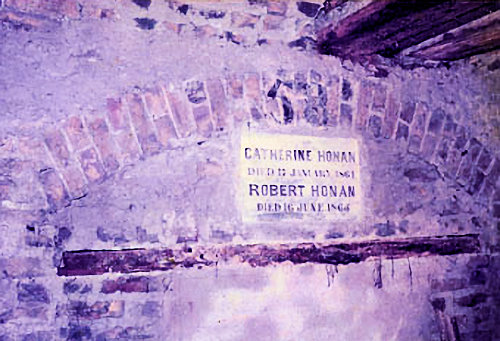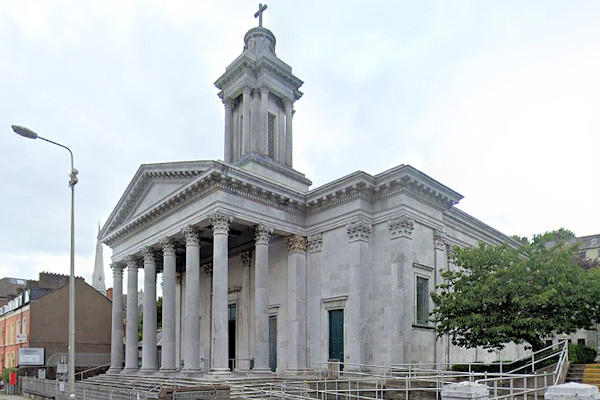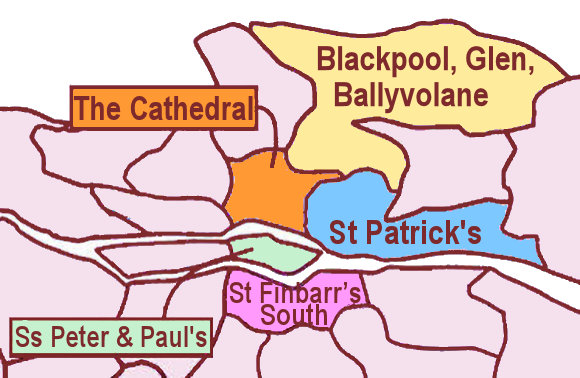The Honans were well established in the commercial life of Limerick City before the 19th century
They moved their business to Cork some time after 1800. Their main premises were at 19/20 St. Patrick's Quay for the processing of butter, and 10/11 King Street (now McCurtain Street); the Metropole Hotel complex is now occupying the site.
Matthew Honan, born1815, became head of the household. He never married but continued to reside with his sister Isabella at the family residence in Sydney Place. He inherited from his father talents of self-discipline, hard work and an application to duty. Its been said of the father that he lived so frugally and was so adversed to wasting time that he took his lunch to his office like a schoolboy would, packed in a little satchel strapped to his back.
 Closed vault of Catherine and Robert Honan
Closed vault of Catherine and Robert Honan
Unlike the Maylors, Dunnes, Roches and numerous other of the Cork mercantile class, the Honans remained severely aloof from public service, and in politics they were Unionists.
It was the Honan Family generosity made possible the building of the Brickfield Church, now known as St. Patrick's Church.
St Patrick's Church
 St Patrick's ChurchThe building of St. Patrick's Church began in 1832 A.D. It was to be a Chapel of Ease to the Cathedral parish and replace the "Brickfield Masshouse" nearer the river which stood further down the Strand Road in the vicinity of the present Glanmire Railway Terminus (Kent Station). Because a brick factory occupied this site it was called Brickfield Chapel. This name lived on in the new chapel although it was some distance up the road. It was the 1829 Emancipation Act that encouraged Catholics to select this prominent position for their house of worship. The building of St. Patrick's was entrusted to a young architect from London, George Pain, who planned a handsome edifice in grecian style..
St Patrick's ChurchThe building of St. Patrick's Church began in 1832 A.D. It was to be a Chapel of Ease to the Cathedral parish and replace the "Brickfield Masshouse" nearer the river which stood further down the Strand Road in the vicinity of the present Glanmire Railway Terminus (Kent Station). Because a brick factory occupied this site it was called Brickfield Chapel. This name lived on in the new chapel although it was some distance up the road. It was the 1829 Emancipation Act that encouraged Catholics to select this prominent position for their house of worship. The building of St. Patrick's was entrusted to a young architect from London, George Pain, who planned a handsome edifice in grecian style..
The exact dates of the design and commencement of construction of the church are unknown. However, a map of Cork dated 1832 clearly shows a 'Friary' on the exact site of St. Patrick's.
The new church was first used for Sunday Mass on 11th. October 1836 but was not completed for many years later. The bell in the tower is inscribed "McSweeney 1843".
The original shape was cruciform. The side-aisles were added in 1894-95 through the generosity of the Honan family. The architect was George Richard Pain, who with his brother James designed other important buildings in Cork e.g. the Courthouse. The church was constructed in classical style and built of Cork limestone.
The priest in charge of its erection from start to finish was a curate of the North Chapel, Patrick W. Coffey. He organised collections and meetings and pushed on the completion of the more decorative parts of the work. His handwriting in beautiful penmanship appears continually in the parish registers from 1830 to 1847 when Fr. Coffey passed away. A plaque in St. Patrick's mourns his passing at the age of 42 years.
St. Patrick's Church was elevated tp the dignity of a parish Church on 1st. July 1848. The first Parish Priest was Rev. Fr. Michael B. O'Shea, who came from S.S. Peter and Paul's and was appointed by the newly consecrated Bishop of Cork, Rev. Dr. Delaney.
While John Murphy was bishop of the diocese (1815 -1847) the main organiser of fund-raising was Fr. Sylvester Mahony C.C. who later for literary purposes took the name of a priest he had known and admired since childhood "Fr Prout". He is best remembered now as the author of the poem "The Bells of Shandon".
St. Patrick's was constituted an independent parish in 1848 and included Mayfield and The Glen and extended out to include Ballyvolane. It is the Mother Church of St. Joseph's, Our Lady Crowned, St Brendan's and St. Oliver's while Holy Family Church was acquired as church-of-ease in 1949 from the Methodist Congregation.

